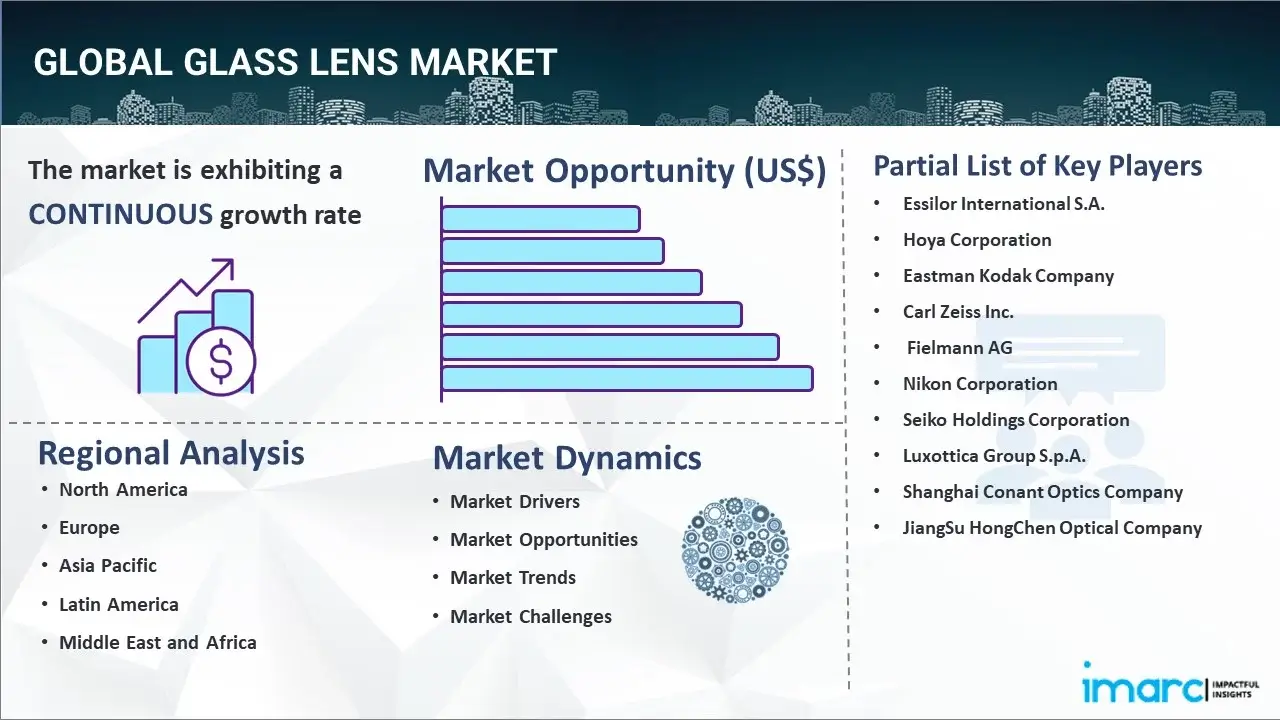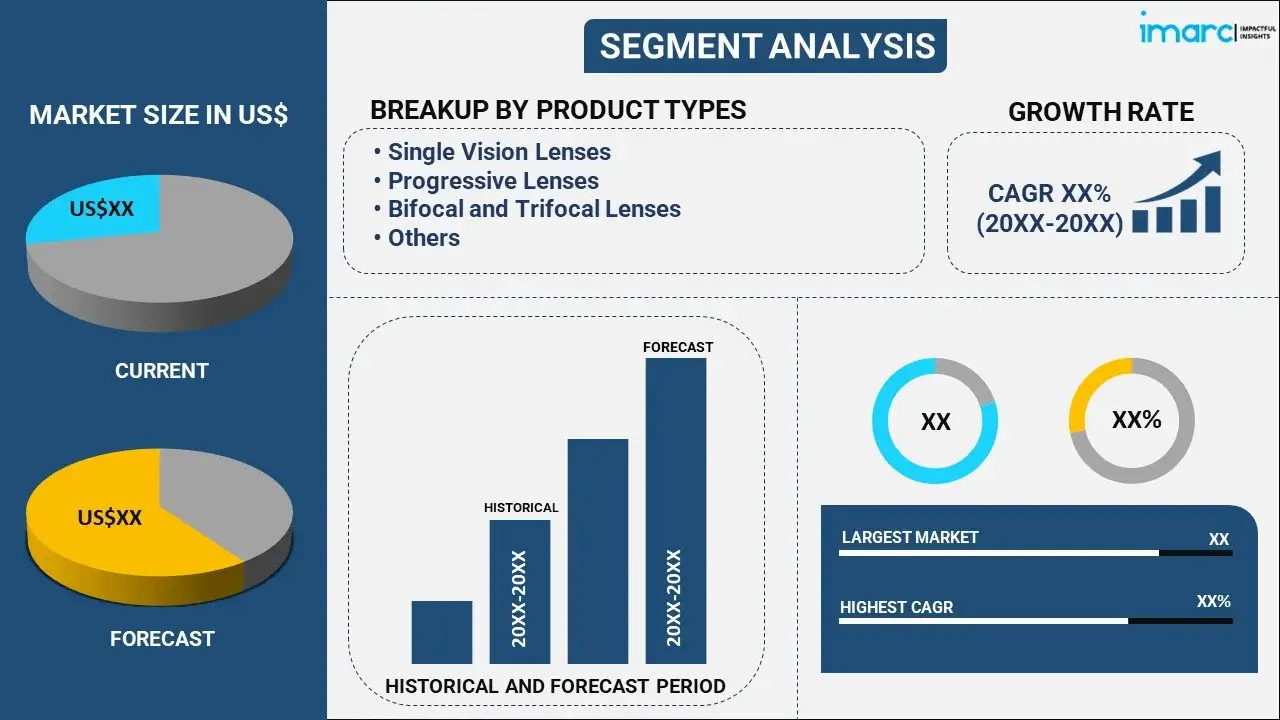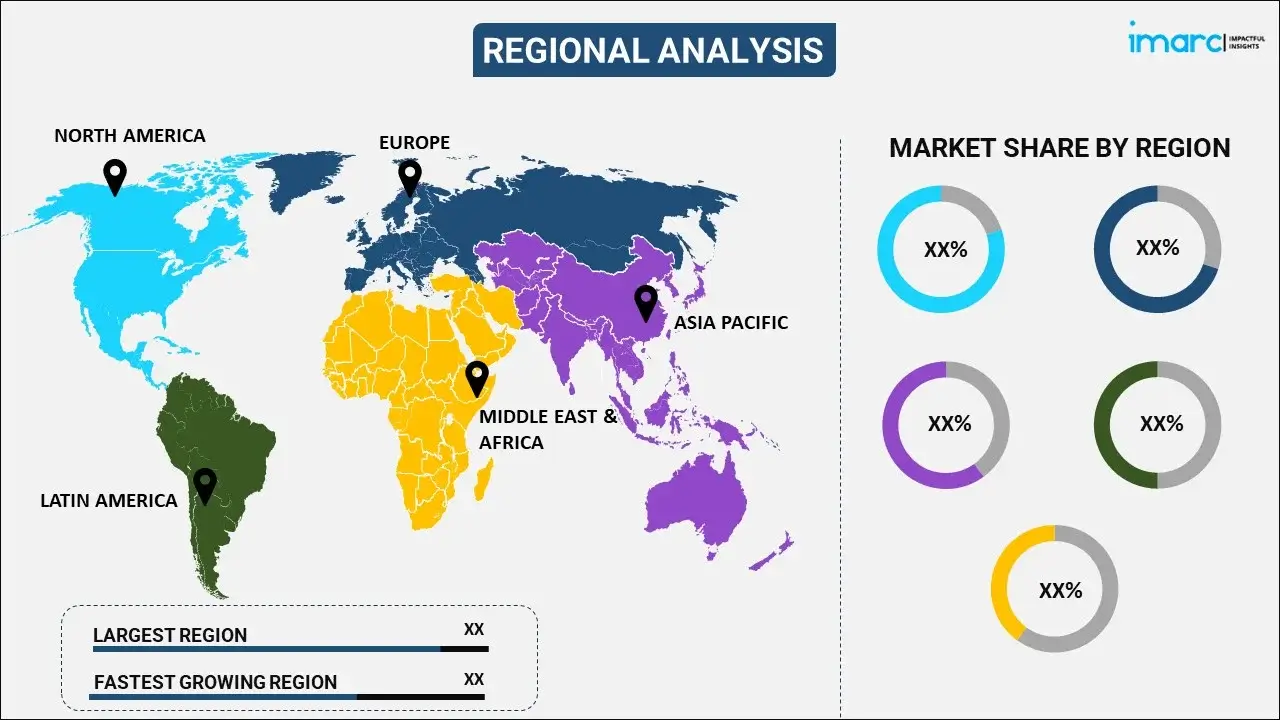IMARC made the whole process easy. Everyone I spoke with via email was polite, easy to deal with, kept their promises regarding delivery timelines and were solutions focused. From my first contact, I was grateful for the professionalism shown by the whole IMARC team. I recommend IMARC to all that need timely, affordable information and advice. My experience with IMARC was excellent and I can not fault it.
Read More
Glass Lens Market Report by Product Type (Single Vision Lenses, Progressive Lenses, Bifocal and Trifocal Lenses, Photochromic Lenses, Polarized Lenses, and Others), Coating (Anti-Reflective, Blue Light Reduction, Scratch-Resistant, UV Protection), Distribution Channel (Offline, Online), and Region 2024-2032
Glass Lens Market Size:
The global glass lens market size reached US$ 46.8 Billion in 2023. Looking forward, IMARC Group expects the market to reach US$ 63.4 Billion by 2032, exhibiting a growth rate (CAGR) of 3.3% during 2024-2032. The market is experiencing robust growth driven by rapid technological advancements in lens manufacturing, increasing prevalence of eye health issues, rising popularity of fashion eyewear, expansion of online retail platforms, and the implementation of supportive government initiatives and healthcare policies.
|
Report Attribute
|
Key Statistics
|
|---|---|
|
Base Year
|
2023
|
|
Forecast Years
|
2024-2032
|
|
Historical Years
|
2018-2023
|
|
Market Size in 2023
|
US$ 46.8 Billion |
|
Market Forecast in 2032
|
US$ 63.4 Billion |
| Market Growth Rate 2024-2032 | 3.3% |
Glass Lens Market Analysis:
- Market Growth and Size: The market is witnessing stable growth, driven by increasing eye health concerns, rapid technological advancements in lens manufacturing, and the widespread expansion of online retail platforms, offering a wide range of eyewear products.
- Major Market Drivers: Key drivers influencing the market growth include rapid technological innovations in lens production, rising prevalence of eye disorders, the growing popularity of fashion eyewear, rapid expansion of e-commerce platforms, and the implementation of supportive government healthcare policies.
- Key Market Trends: The key market trends involve the ongoing shift towards multifunctional lenses, like progressive lenses and those offering blue light filtration and ultraviolet (UV) protection. Additionally, the integration of digital technologies in product development and retail strategies to enhance consumer experience and market reach is bolstering the market growth.
- Geographical Trends: North America leads the market due to its advanced healthcare infrastructure and high consumer spending power. Other regions are also showing significant growth, fueled by increasing awareness about eye health, rising disposable incomes, and expanding healthcare facilities.
- Competitive Landscape: The market is characterized by the active involvement of key players who are focusing on research and development (R&D) for product innovation, online retail enhancement, and sustainable manufacturing practices. Furthermore, companies are engaging in collaborations with industry leaders, technology firms, and fashion brands, to create diverse product offerings and expand market presence.
- Challenges and Opportunities: The market faces various challenges, such as competition from low-cost manufacturers and meeting the evolving consumer demands for style, comfort, and functionality. However, the rising focus on leveraging e-commerce platforms, and catering to the growing demand for eco-friendly and technologically advanced lenses are creating new opportunities for the market growth.

Glass Lens Market Trends:
Rapid technological advancements in lens manufacturing
The rapid innovations in lens production, leading to the development of high-quality, durable, and more visually appealing lenses, are creating a positive outlook for the market growth. In line with this, the increasing utilization of advanced materials, like high-index plastics and polycarbonates in glass lenses, that are lightweight and offer better clarity are positively impacting the market growth. Additionally, the rising improvements in coating technologies, such as anti-reflective and scratch-resistant coatings that enhance the functionality and lifespan of glass lenses, are fostering the market growth. Moreover, the heightened adoption of computer-aided design (CAD) and computer-aided manufacturing (CAM) in lens production to improve precision and customization options is acting as a growth-inducing factor. Furthermore, the integration of digital technologies, like three-dimensional (3D) printing, to produce lenses tailored to individual specifications with greater efficiency and lower waste is providing an impetus to the market growth.
Increasing prevalence of eye-related issues
The rising prevalence of eye health issues, such as myopia, hyperopia, and presbyopia, is a major factor driving the market growth. In line with this, the increasing number of people requiring corrective lenses is fueling the market growth. Moreover, the growing geriatric population across the globe, who are susceptible to age-related vision impairments, is anticipated to drive the market growth. In addition to this, the increasing prevalence of diabetes, which can lead to diabetic retinopathy, propelling the need for regular eye check-ups and corrective lenses, is favoring the market growth. Furthermore, the heightened screen time of consumers, leading to digital eye strain is strengthening the market growth. Along with this, the rising awareness about eye health and the availability of vision correction solutions are contributing to the market growth.
Growing popularity of fashion eyewear
The growing popularity of using eyeglasses as a fashion accessory, spurring the demand for stylish and designer frames equipped with high-quality glass lenses, is creating a positive outlook for the market growth. Moreover, the rising investment in multiple pairs of eyeglasses to match different outfits and occasions is boosting the market growth. Besides this, the increasing influence of celebrities and fashion influencers who endorse eyewear brands is catalyzing the market growth. In addition to this, the rising popularity of customizable and limited-edition frames, allowing consumers to express individuality through their eyewear, is acting as a growth-inducing factor. Along with this, the increasing collaborations between eyewear designers, artists, and fashion designers to create unique, trendsetting pieces are fueling the market growth. Furthermore, the rapid convergence of fashion and eyewear, leading to product diversification and heightened perceived value of eyeglasses, is stimulating the market growth.
Expansion of online retail platforms
The emergence of the e-commerce sector and online retail platforms that offer a wide range of eyewear products, including prescription glasses, sunglasses, and contact lenses, is a major factor contributing to the market growth. Moreover, the rising convenience of online shopping, coupled with the ability to choose from a vast array of styles and brands, is boosting the market growth. Additionally, rapid technological advancements, such as virtual try-on features and online vision tests that enhance the shopping experience for eyewear, are providing a considerable boost to the market growth. Besides this, the integration of advanced technologies, like artificial intelligence (AI) and machine learning (ML), that analyze consumer preferences and buying patterns to suggest products and enhance customer experience is fostering the market growth.
Implementation of government healthcare initiatives and policies
The implementation of various government initiatives and healthcare policies to increase awareness about eye health and provide subsidized or free vision care services is anticipated to drive the market growth. Moreover, they aim to reduce the incidence of preventable vision problems and increase access to eyewear. Furthermore, the introduction of health insurance policies that cover vision care, including the cost of prescription glasses, encouraging people to seek regular eye examinations and corrective lenses, is fostering the market growth. Along with this, the increasing investments in government-funded research into eye health, leading to breakthroughs in lens technology and design, are providing a thrust to the market growth. Besides this, the widespread organization of public health campaigns to raise awareness about eye health, propelling the demand for eye examinations and corrective lenses, is supporting the market growth.
Glass Lens Industry Segmentation:
IMARC Group provides an analysis of the key trends in each segment of the market, along with forecasts at the global and regional levels for 2024-2032. Our report has categorized the market based on product type, coating, and distribution channel.
Breakup by Product Type:

- Single Vision Lenses
- Progressive Lenses
- Bifocal and Trifocal Lenses
- Photochromic Lenses
- Polarized Lenses
- Others
Progressive lenses account for the majority of the market share
The report has provided a detailed breakup and analysis of the market based on the product type. This includes single vision lenses, progressive lenses, bifocal and trifocal lenses, photochromic lenses, polarized lenses, and others. According to the report, progressive lenses represented the largest segment.
Progressive lenses represent the largest segment as they cater to a broad age group. They offer a seamless transition between multiple focal points, correcting vision at all distances without the visible lines found in bifocal or trifocal lenses. Moreover, the rising popularity of progressive lenses, due to their convenience and aesthetic appeal, is providing an impetus to the market growth. Additionally, they offer a more youthful look compared to traditional multifocal lenses. Along with this, rapid technological advancements that improve the design of progressive lenses while reducing issues like motion blur and offering wider fields of vision are enhancing the market growth.
Single-vision lenses are designed to correct a single field of vision. They are utilized by individuals with specific vision correction needs, such as nearsightedness or farsightedness. Moreover, they are known for their simplicity and affordability, making them a popular choice for younger demographics and for those requiring vision correction for the first time.
Bifocal and trifocal lenses are utilized by individuals with multiple vision correction needs, such as near and distant vision. Bifocals have two distinct optical powers, while trifocals add an intermediate range. Along with this, the increasing demand for bifocal and trifocal lenses, due to their cost-effectiveness and accessibility, is providing a thrust to the market growth.
Photochromic lenses adjust their tint based on light exposure and are known for their convenience and protective features. Moreover, they darken in sunlight, providing ultraviolet (UV) protection and reducing glare, and then clear up indoors or in low-light conditions. In line with this, the increasing utilization of photochromic lenses by individuals who spend a significant amount of time outdoors or who prefer not to switch between prescription glasses and sunglasses is favoring the market growth.
Polarized lenses are known for their ability to reduce glare from reflective surfaces like water, snow, and glass. They are widely utilized by outdoor enthusiasts and drivers. Moreover, polarized lenses enhance visual clarity and comfort by filtering out horizontal light waves. Besides this, the increasing demand for polarized lenses, as more consumers engage in outdoor activities and become aware of the benefits of glare reduction, is fostering the market growth.
Breakup by Coating:
- Anti-Reflective
- Blue Light Reduction
- Scratch-Resistant
- UV Protection
Anti-reflective holds the largest share in the industry
A detailed breakup and analysis of the market based on the coating have also been provided in the report. This includes anti-reflective, blue light reduction, scratch-resistant, and UV protection. According to the report, anti-reflective accounted for the largest market share.
Anti-reflective (AR) coating represents the largest market share as it enhances the clarity and comfort of eyeglasses by reducing reflections from the lens surfaces. It allows more light to pass through, improving vision sharpness and reducing glare, especially during nighttime driving or while using digital screens. Moreover, anti-reflective coating makes the lenses nearly invisible, offering an aesthetic benefit while highlighting the eyes and reducing the distractions of reflections on the lens. Besides this, the rising demand for AR coating due to the increasing utilization of digital devices and greater consumer awareness about the benefits of reduced glare and eye strain are fostering the market growth.
Blue light reduction coatings are designed to filter out a portion of blue light to reduce digital eye strain and improve sleep quality. The increasing awareness about the potential impacts of prolonged exposure to digital screens is a major factor boosting the market growth. Besides this, the rising demand for specialized coatings among office workers, gamers, and young adults, owing to the heightened screen time, is fueling the market growth.
Scratch-resistant coatings are essential for prolonging the lifespan and maintaining the clarity of glass lenses. They add a protective layer that makes lenses more resistant to everyday wear and tear. Along with this, scratch-resistant coatings reduce the chances of minor scratches that can impair vision and affect the aesthetic appeal of eyeglasses.
Ultraviolet (UV) protection coatings offer defense against harmful ultraviolet rays. They are important for clear and sunglass lenses, as prolonged UV exposure can contribute to eye health issues like cataracts and macular degeneration. Besides this, the increasing awareness among consumers about the need for UV-blocking coatings to protect eyes is fostering the market growth.
Breakup by Distribution Channel:
- Offline
- Online
Offline represents the leading market segment
The report has provided a detailed breakup and analysis of the market based on the distribution channel. This includes offline and online. According to the report, offline represented the largest segment.
The offline distribution channel holds the largest segment as it includes traditional brick-and-mortar stores, such as optometry clinics, eyewear retail stores, and department stores that offer the advantage of personalized services. They include professional eye examinations, face-to-face consultations, and the ability to try on multiple frames for fit and comfort. Moreover, the tactile experience and the professional advice consumers receive at physical locations are boosting the market growth. Moreover, the increasing visits to offline channels for complex prescription needs, as they provide the assurance of accuracy and personalized fitting, are acting as a growth-inducing factor. Along with this, the strong trust and credibility associated with in-person professional advice is enhancing the market growth.
The online distribution channel offers the convenience of shopping from home and provides a wider selection of styles and brands. Moreover, the rising popularity of online stores, as they enhance the customer experience with tools like virtual try-on technology and online eye tests, is stimulating the market growth. Additionally, the availability of competitive pricing and frequent promotions online, boosting its adoption among cost-conscious consumers, is enhancing the market growth.
Breakup by Region:

- North America
- Europe
- Asia Pacific
- Middle East and Africa
- Latin America
North America leads the market, accounting for the largest glass lens market share
The market research report has also provided a comprehensive analysis of all the major regional markets, which include North America, Europe, Asia Pacific, the Middle East and Africa and Latin America. According to the report, North America accounted for the largest market share.
North America represents the largest market share, driven by high consumer spending power, a well-established healthcare infrastructure, and a strong presence of leading eyewear manufacturers and brands. Moreover, the increasing prevalence of vision-related issues due to lifestyle factors and a growing geriatric population is propelling the market growth. Additionally, the rising interest in fashionable eyewear and the growing awareness about eye health in the region are bolstering the market growth. Furthermore, the heightened demand for advanced lens technologies, such as progressive lenses and specialized coatings, reflecting the region's inclination towards high-quality and multifunctional eyewear, is anticipated to drive the market growth.
The Asia Pacific region is experiencing rapid growth in the market, attributed to increasing awareness of eye health, rising disposable incomes, and expanding healthcare infrastructure. Moreover, the large consumer base and a growing geriatric population in the region, requiring the need for vision correction, is favoring the market growth. Additionally, the presence of key manufacturers along with the rising popularity of fashion eyewear, is contributing to the market growth.
Europe's glass lens market is characterized by a high demand for premium and branded eyewear, along with a strong focus on quality and design. Furthermore, the presence of several renowned eyewear designers and manufacturers, leading to the development of innovative and high-end eyewear, is fostering the market growth. Additionally, the growing geriatric population, boosting the demand for multifocal and specialized lenses, is fueling the market growth.
In Latin America, the glass lens market is growing steadily, driven by improvements in healthcare accessibility and an increasing middle-class population. Moreover, rapid urbanization and lifestyle changes, leading to a higher prevalence of vision-related issues, are contributing to the market growth. Besides this, the increasing influence of fashion trends in eyewear and the growing awareness of the importance of UV protection for eye health are favoring the market growth.
The glass lens market in the Middle East and Africa is emerging due to factors such as economic development, increasing healthcare spending, and a growing awareness of eye health. Moreover, the rising popularity of luxury eyewear, due to the region's high disposable incomes and preference for luxury brands, is acting as a growth-inducing factor.
Leading Key Players in the Glass Lens Industry:
The major players are engaged in various strategic activities to strengthen their market positions. They are investing in research and development (R&D) to introduce innovative products that offer better comfort, durability, and functionality. Moreover, some companies are developing advanced lens technologies, such as thinner, lighter materials and specialized coatings, due to their blue light filtration and anti-reflective properties. Besides this, they are expanding their digital footprint by enhancing online retail platforms to cater to the growing demand for e-commerce solutions. Furthermore, leading players are engaging in collaborations and partnerships with technology firms, fashion brands, and healthcare providers to expand their market reach and product offerings.
The market research report has provided a comprehensive analysis of the competitive landscape. Detailed profiles of all major companies have also been provided. Some of the key players in the market include:
- Essilor International S.A.
- Hoya Corporation
- Eastman Kodak Company
- Carl Zeiss Inc.
- Fielmann AG
- Nikon Corporation
- Seiko Holdings Corporation
- Luxottica Group S.p.A.
- Shanghai Conant Optics Company
- JiangSu HongChen Optical Company
(Please note that this is only a partial list of the key players, and the complete list is provided in the report.)
Latest News:
- In January 2024, Essilor International S.A. introduced the Varilux X series, a new vision frontier to enhance the visual experience of presbyopes.
- In January 2024, Carl Zeiss Inc. launched ZEISS Light 2, a new addition to the ZEISS Progressive lens portfolio along with ZEISS SmartLife lenses.
- In November 2023, Luxottica Group S.p.A. and Moncler announced the signing of an exclusive licensing agreement that includes the design, production, and global distribution of Moncler eyewear.
Glass Lens Market Report Scope:
| Report Features | Details |
|---|---|
| Base Year of the Analysis | 2023 |
| Historical Period | 2018-2023 |
| Forecast Period | 2024-2032 |
| Units | US$ Billion |
| Scope of the Report | Exploration of Historical Trends and Market Outlook, Industry Catalysts and Challenges, Segment-Wise Historical and Future Market Assessment:
|
| Product Types Covered | Single Vision Lenses, Progressive Lenses, Bifocal and Trifocal Lenses, Photochromic Lenses, Polarized Lenses, Others |
| Coatings Covered | Anti-Reflective, Blue Light Reduction, Scratch-Resistant, UV Protection |
| Distribution Channels Covered | Offline, Online |
| Regions Covered | Asia Pacific, Europe, North America, Latin America, Middle East and Africa |
| Companies Covered | Essilor International S.A., Hoya Corporation, Eastman Kodak Company, Carl Zeiss Inc., Fielmann AG, Nikon Corporation, Seiko Holdings Corporation, Luxottica Group S.p.A., Shanghai Conant Optics Company, JiangSu HongChen Optical Company, etc. (Please note that this is only a partial list of the key players, and the complete list is provided in the report.) |
| Customization Scope | 10% Free Customization |
| Report Price and Purchase Option | Single User License: US$ 3899 Five User License: US$ 4899 Corporate License: US$ 5899 |
| Post-Sale Analyst Support | 10-12 Weeks |
| Delivery Format | PDF and Excel through Email (We can also provide the editable version of the report in PPT/Word format on special request) |
Key Questions Answered in This Report:
- How has the global glass lens market performed so far, and how will it perform in the coming years?
- What are the drivers, restraints, and opportunities in the global glass lens market?
- What is the impact of each driver, restraint, and opportunity on the global glass lens market?
- What are the key regional markets?
- Which countries represent the most attractive glass lens market?
- What is the breakup of the market based on the product type?
- Which is the most attractive product type in the glass lens market?
- What is the breakup of the market based on the coating?
- Which is the most attractive coating in the glass lens market?
- What is the breakup of the market based on the distribution channel?
- Which is the most attractive distribution channel in the glass lens market?
- What is the competitive structure of the market?
- Who are the key players/companies in the global glass lens market?
Key Benefits for Stakeholders:
- IMARC’s industry report offers a comprehensive quantitative analysis of various market segments, historical and current market trends, market forecasts, and dynamics of the glass lens market from 2018-2032.
- The research report provides the latest information on the market drivers, challenges, and opportunities in the global glass lens market.
- The study maps the leading, as well as the fastest-growing, regional markets.
- Porter's five forces analysis assists stakeholders in assessing the impact of new entrants, competitive rivalry, supplier power, buyer power, and the threat of substitution. It helps stakeholders to analyze the level of competition within the glass lens industry and its attractiveness.
- The competitive landscape allows stakeholders to understand their competitive environment and provides insight into the current positions of key players in the market.
Need more help?
- Speak to our experienced analysts for insights on the current market scenarios.
- Include additional segments and countries to customize the report as per your requirement.
- Gain an unparalleled competitive advantage in your domain by understanding how to utilize the report and positively impacting your operations and revenue.
- For further assistance, please connect with our analysts.

Purchase options
Benefits of Customization
Personalize this research
Triangulate with your data
Get data as per your format and definition
Gain a deeper dive into a specific application, geography, customer, or competitor
Any level of personalization
Get in Touch With Us

UNITED STATES
Phone: +1-631-791-1145

INDIA
Phone: +91-120-433-0800

UNITED KINGDOM
Phone: +44-753-713-2163
Email: sales@imarcgroup.com
 Inquire Before Buying
Inquire Before Buying Speak to an Analyst
Speak to an Analyst  Request Brochure
Request Brochure  Request Customization
Request Customization



.webp)




.webp)
